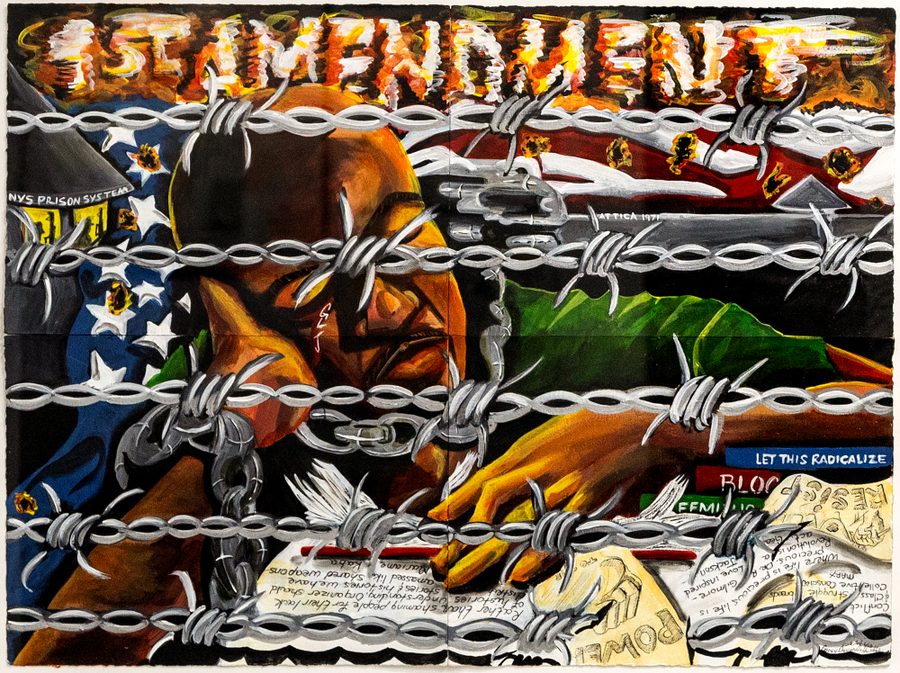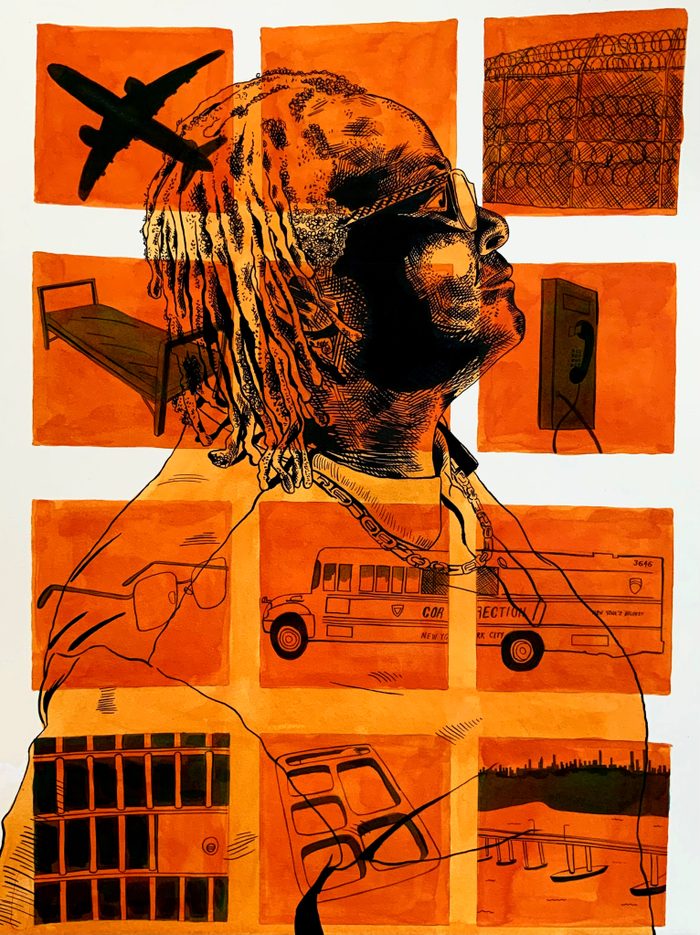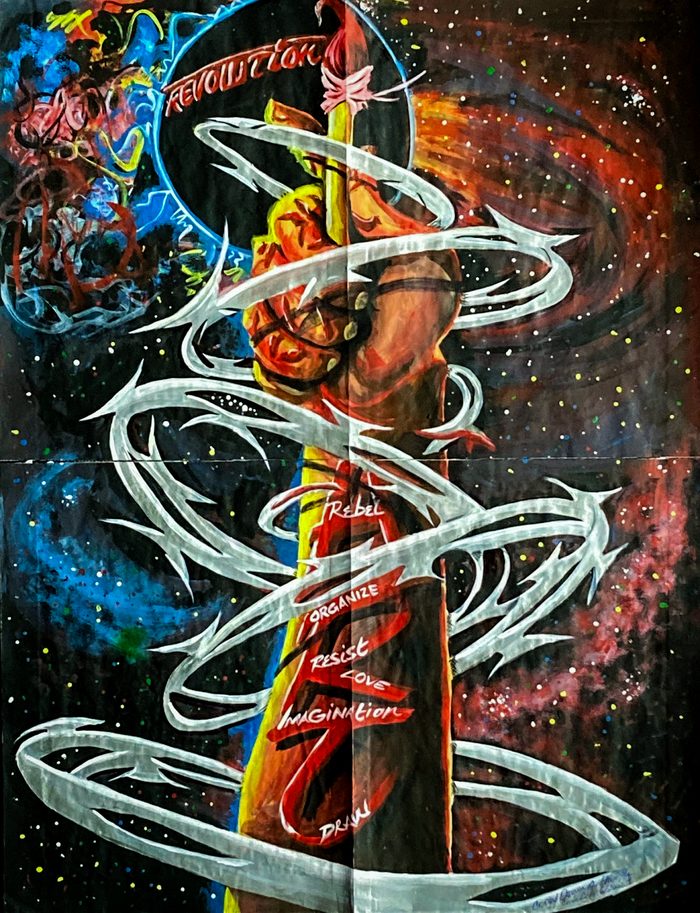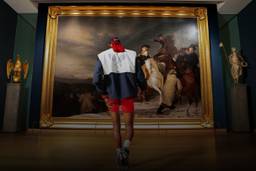“Prison Itself Is Censorship”: Mariame Kaba on the Freedom to Read
52 years after the Attica uprising, a new exhibit by the author of “We Do This ’Til We Free Us” explores carceral book bans.
Jack McCordick

On one wall of a fluorescent-lit art space in midtown Manhattan, 99 fake library cards are laid out in five neat rows. Most bear the title of a classic work of revolutionary history, philosophy, political economy or literature, though a handful are a bit more obscure (early health food advocate Euell Gibbons’ Stalking the Blue-Eyed Scallop, for example). All have the same due date — August 20, 1971 — one day before George Jackson died.
Prison guards killed the Black revolutionary in California’s San Quentin prison, and Jackson’s death rippled throughout the U.S. carceral system. His life was part of the spark that ignited the fabled revolt in Attica, N.Y., the following month.
The 99 books listed on the wall were found in Jackson’s cell.
September marked the 52nd anniversary of the uprising at Attica Prison, in which more than a thousand men took control of the overcrowded maximum security facility, where all the guards were white and over half of the prisoners were Black. The groundwork for the five-day uprising, against the prison’s dehumanizing and humiliating conditions, was laid by the Attica Liberation Faction, a group of five incarcerated men who had spent the previous summer reading revolutionary texts by Karl Marx, Vladimir Lenin, Leon Trotsky, Malcolm X, W.E.B. Du Bois, Frederick Douglass and others. Working as a representative democracy, the group called for an end to the “ruthless brutalization and disregard for the lives of the prisoners here and throughout the United States.”
Their demands ranged widely but included an end to the censoring of reading materials and an expansion of the facility’s educational programming. “We are men,” the group wrote in its Declaration to the People of America. “We are not beasts and we do not intend to be beaten or driven as such.”
A day after the anniversary of the uprising’s bloody end — when police shot and killed 29 revolutionaries and 10 hostages — I walk to EFA Project Space in midtown Manhattan for the opening of Return to Sender: Prison as Censorship, a new exhibition featuring art and writing by incarcerated artists. The exhibition is curated by abolitionist writer and organizer Mariame Kaba, who has been working on prison censorship for years. As founder and director of Project NIA, a Chicago-based abolitionist organization focused on incarcerated youth, Kaba helped found Liberation Library, which has been sending books to youth in Illinois prisons and jails since 2015. She has also authored a number of abolitionist texts, including the New York Times bestseller We Do This ‘Til We Free Us.
The library card installation, co-curated by Kaba, invites viewers to reflect on the kinds of radical texts Jackson had access to over half a century ago, and to stick Post-it notes on the titles they think would most likely be censored in U.S. prisons today. When I return to the exhibit the following week, the most-covered titles are works such as Herbert Aptheker’s American Negro Slave Revolts, Karl Marx’s Das Capital, Ralph Ellison’s Invisible Man and Frantz Fanon’s Black Skin, White Masks, as well as books on the lives of Malcolm X, Che Guevara, Fidel Castro and pan-African anti-colonialist George Padmore.
“You can generally tell what processes a man’s mind has gone through by what he’s studied, observed,” Jackson wrote in Blood in My Eye, the book he finished writing days before his death.
On the day I return, Kaba admits the interactive part of the installation is “kind of a trick question.” Every one of the books that were in George Jackson’s cell would likely be censored today, she tells me. “The prison of 1971 is not the prison of 2023,” she says. “The prison of 2023, in most ways, is worse than the prison of 1971. Worse in terms of surveillance, worse in terms of control, worse in terms of what people can say.”
When Jackson first went to prison in 1960, the U.S. incarcerated population was about 10% of what it is today.
Prisons are undoubtedly the most restrictive reading environments in the country. The venerable, century-old free expression nonprofit PEN America, which co-sponsored Return to Sender, has described the book restriction policies currently in place in the U.S. carceral system as the “largest book ban policy” in the country.
And it’s not just bans on individual books. Across prisons and jails, censorship policies are labyrinthine and ever-changing. In April, Chicago’s Cook County Jail declared all paper to be contraband, due to some alleged instances of drug-laced paper entering the jail. A month later, the New York Department of Corrections and Community Supervision announced it was giving prison superintendents the power to block any creative work from publication if found in violation of certain broad rules. (The order was rescinded following reporting from New York Focus, a nonprofit news outlet.)
Yet, as attention rises on Republican-led book banning in U.S. schools and libraries — “institutions that nice, middleclass people feel very precious about,” Kaba says — the state of censorship in prisons remains relatively unnoticed. According to Kaba, the “techniques of censorship” that have proliferated throughout U.S. society in recent years were first refined and perfected in its jails and prisons. “The prison is not ‘some place, somewhere else,’ ” she says to a crowd of about 60 people gathered for the exhibition’s opening. “The prison extends into all parts of our community.”

That evening, Kaba holds up the Attica uprising as an “emblematic example of resistance” to the prison-industrial complex. But there are “other kinds of resistance happening every day” in prisons, she says, as incarcerated artists and writers fight against an ever-expanding censorship regime. She offers the example of Corey Devon Arthur, an artist incarcerated in New York who paints from his cell using materials he must purchase himself (his prison doesn’t have an art program), and who was forced to mail his two paintings to the exhibit in four separate pieces, hoping each made it safely to the curators.
Three separate artworks in Return to Sender offer contemporary, censorship-focused reimaginings of famed artist Faith Ringgold’s “United States of Attica,” a map of the United States created in 1972 to honor the revolutionaries who died in the uprising. While Ringgold’s map is dotted with the names of historical genocides and murders dating back to the colonial era, the updated versions, produced by artists Danbee Kim, Kruttika Susarla and Pablo Mendoza, are sprinkled with language from some of the draconian prison censorship policies — “no non-English,” “only from Amazon,” “no used books” — currently in place in states across the country.
Ringgold noted that her map’s catalog of American violence was unfinished, while Kim, creator of the Ringgold-inspired painting “United States of Redacted,” notes the impossibility of fully documenting the extent of censorship in prisons.
The Attica uprising also motivated PEN America to establish the PEN Prison Writing Program in 1971, later renamed the Prison and Justice Writing Program, which pairs imprisoned writers with mentors on the outside. For Return to Sender, PEN set up a mock prison mailroom, complete with a writing station for visitors to send letters to some of the currently incarcerated artists whose work is in the exhibition. Each time I passed through the space during the opening reception, multiple exhibition-goers were bent over legal pads, scribbling out notes addressed to carceral facilities in New York, Texas, Kentucky, Minnesota and Mississippi.
As part of the exhibition, Kaba also oversaw the building of a mock prison cell, surrounded by walls painted in what she calls an “ugly, institutional green.”
“We’re talking about prison,” Kaba says bluntly. “I wanted something in here that reflected that.”

Directly across the exhibition space from the mock prison bars is what she calls the “antithesis of the cell” — a mini-library, complete with couches and chairs and full of books on police abolition and Black feminism, curated by the Free Black Women’s Library, a literary and community care space located in Bed-Stuy, Brooklyn.
Hector Rodriguez, an artist whose work is featured in the exhibition and who served more than 27 years in the New York Department of Corrections and Community Supervision before he was released in February, spoke to the crowd gathered at the opening. “On a number of occasions, books were denied to me because the prison found them to be a threat. ‘A threat to whom or to what?’ I asked myself,” he says. “It was clear to me that the threat the Department of Corruption was referring to was my education. My education is a threat to white supremacy and its structural roots.”
Kaba acknowledges that not every organization involved in the exhibition endorses prison abolitionism, but she argues that prison censorship should nonetheless be understood through an abolitionist lens— because the issue is not just about restoring piecemeal access to individual books. (Kaba says she does, however, consider restoring access to information in prisons as a “non-reformist reform,” an action that reduces the harm caused by carceral institutions while pointing toward an abolitionist horizon.) The exhibition, Kaba says, “asserts that the prison in and of itself is censorship. … We cannot eradicate censorship in prisons, as prisons exist to censor people. That is their role.” Or, as Kaba concludes her speech: “We must care about prison censorship, but we must also end the prison. That’s my clarion call.”
Kaba’s comments put me in mind of something Toni Morrison said in The Pieces I Am, a documentary about her life released just a few months before her death in 2019. Morrison, whose books are some of the most frequently banned across the country, received a letter from Texas prison authorities informing her that her 1998 novel, Paradise, had been censored “because it might incite a riot.”
Morrison’s response: “I thought, ‘How powerful is that?’ I could tear up the whole place.”
Jack McCordick is a reporter-researcher at The New
Republic. He lives in New York.






